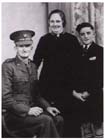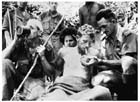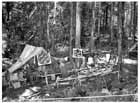As a chaplain in the Salvation Army major Moore was a non-combatant in New Guinea, but he was actively involved in supporting the Australian war effort from amidst the jungle battlefield. Moore perceived his own role as one of providing support, encouragement and care to the troops. He had developed a reputation in the Middle East for the extreme lengths he would go to, and the personal risks he would assume, in order to take the news and comfort to the troops doing the fighting. Moore seemed only to extend on this reputation by his similar exertions for the troops in New Guinea. He himself believed his efforts there to have been "the most compensating of any service [he] had tried to render to the men of the forces", as it was the most hellish place he could imagine.
Major Moore was the driving force behind the establishment of a "coffee and comfort bar" in the depths of the Owen Stanley Ranges. He organized the construction of a refreshment centre, for exhausted and wounded troops, alongside the Kokoda Track at the foot of the incredibly fatiguing Golden Stairs. In the midst of a depressing trail could even be found the Red Shield"s famous "Hop-In" sign, and this provided approaching troops with encouragement and increased morale. Moore was able to sustain his refreshment operations because he, after considerable effort, had managed to persuade the administrative forces to grant him a team of fifteen natives whose "unfailingly faithful support" kept the necessary supplies coming in. At times the station provided the troops with an average of 45 gallons of hot coffee a day, despite the difficulties of keeping things hot with only kerosene tins and a couple of urns.
Moore encountered incredibly exhausted and battered men returning from violent fighting, as well as those on their way there. Through this contact he was well positioned to see the generosity and compassion of the men towards others. Moore had laid out his entire stash of smokes, which was quite an amount, for the 31st when they reached the foot of the Golden Stairs, and invited the men to help themselves. He "was amazed at their reaction as one after another these men declared as they walked off with their tea or coffee, "leave them for the fellows coming out they will need them more than I do" and strangely enough the fellows coming out invariably said "leave them for the chappies going in they will need them more than I will"."
As the Australians were pushed back by the Japanese the Salvation Army post became close to the front line. Moore could hear the mountain guns and small arms fire. On 16 September 1942 he was urgently ordered to pack up and move back because of the enemy advances. Although reluctant to leave his post he complied with the orders, but was already planning where he would reestablish his refreshment operation. On arrival at his fall back location he found that the YMCA had beat him to it. Moore was angered that the YMCA might come to be taking comforts to the troops further forward than the Salvation Army. Moore was incredibly competitive in this respect and determined that the Salvo's should be the premier organization. He "wondered what the Salvation Army men in Moresby were doing to let the YMCA get in here. I loved the YMCA but I hated to know they were in front of us, and up to this point I had always managed to keep in front; horrible spirit but this was mutual, all good pals but the competition was keen and the men got the benefit of it."
Perhaps one of the most touching contributions to the men's morale and comfort that Moore provided were the scones and jam tarts he baked for them. The ingredients were pretty basic, but still hard to acquire, and yet Moore managed to produce hundreds of his scones, from the oven he had made from a biscuit tin buried in the ground. Despite on occasion having been baked from flour that "came alive" with weavils, the scones and jam tarts were greatly appreciated by men who had seen nothing but hard rations- bully beef and hard dog biscuits- for weeks. Moore's philosophy was that "when you are hungry; sour grapes can taste sweet."
(Source: Australian War Memorial PR85/275)
Chaplains:
 Overview text
Overview text Longer text
Longer text  Images
Images  Readings
Readings  Albert Moore
Albert Moore  Arnold Potts
Arnold Potts  Harvey Blundell
Harvey Blundell  Kiki Baiyane
Kiki Baiyane  Map
MapClick images to enlarge.

AWM P00525.010

AWM 013287

AWM 027002

AWM 073287
